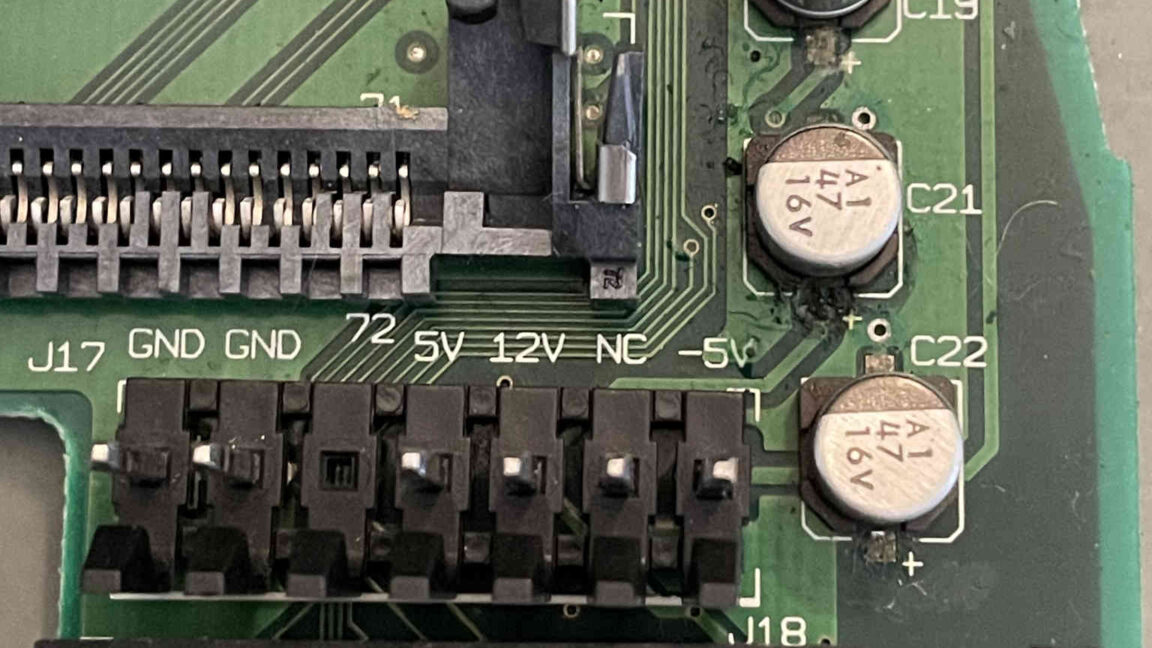
The upside-down capacitor in mid-90s Macs, proven and documented by hobbyists
arstechnica.com
Apple always did things differently The upside-down capacitor in mid-90s Macs, proven and documented by hobbyists A "copy/paste error" on a Mac logic board has led to some restoration problems. Kevin Purdy Nov 29, 2024 7:02 am | 121 The capacitor is not upside-down, visually/orientation-wise, but in voltage. You'll notice if you try to replace it and smell ozone. Credit: Doug Brown The capacitor is not upside-down, visually/orientation-wise, but in voltage. You'll notice if you try to replace it and smell ozone. Credit: Doug Brown Story textSizeSmallStandardLargeWidth *StandardWideLinksStandardOrange* Subscribers only Learn more"Am I the first person to discover this?" is a tricky question when it comes to classic Macs, some of the most pored-over devices on the planet. But there's a lot to suggest that user paul.gaastra, on the 68kMLA vintage Mac forum, has been right for more than a decade: One of the capacitors on the Apple mid-'90s Mac LC III was installed backward due to faulty silkscreen printing on the board.It seems unlikely that Apple will issue a factory recall for the LC IIIor the related LC III+, or Performa models 450, 460, 466, or 467 with the same board design. The "pizza box" models, sold from 19931996, came with a standard 90-day warranty, and most of them probably ran without issue. It's when people try to fix up these boards and replace the capacitors, in what is generally a good practice (re-capping), that they run into trouble. The Macintosh LC III, forerunner to a bunch of computers with a single misaligned capacitor. Credit: Akbkuku / Wikimedia Commons The Macintosh LC III, forerunner to a bunch of computers with a single misaligned capacitor. Credit: Akbkuku / Wikimedia Commons Doug Brown took part in the original 2013 forum discussion, and has seen it pop up elsewhere. Now, having "bought a Performa 450 complete with its original leaky capacitors," he can double-check Apple's board layout 30 years later and detail it all in a blog post (seen originally at the Adafruit blog). He confirms what a bunch of multimeter-wielding types long suspected: Apple put the plus where the minus should be.Specifically, in the corner of the LC III board, near the power supply connector, there are three capacitors nearby, C19, C21, and C22. Each is boxed in with white silkscreen markings, to guide the factory assemblers and future repairs. Each capacitor sits on one of the "rails" (DC power from the supply). While C19 and C21 are properly taking on +5V and +12V lines from the power supply connector, the bottom C22 capacitor is taking a -5V rail into its positive terminal. This capacitor (an SMD electrolytic) is not supposed to take negative voltage.Brown notes that the predecessor Mac LC and LC II had the correct connections, as did the LC 475, which uses the same power supply scheme. This makes him "confident that Apple made a boo-boo on the LC III," or "basically the hardware equivalent of a copy/paste error when you're writing code."Making sure rehabbers don't make the same mistakeWhy was this not noticed earlier, other than a couple forum threads seen by dedicated board rehabbers? There are a few reasons. For one thing, the rail was only used for a serial port or certain expansion card needs, so a capacitor failure, or out-of-spec power output, may not have been noticed. The other bit is that the original capacitor was rated for 16V, so even with -5V across it, it might not have failed, at least while it was relatively fresh. And it would not have failed in quite so spectacular a fashion as to generate stories and myths.As to whether Apple knew about this but decided against acting on a somewhat obscure fault, one that might never cause real problems? By all means, let us know if you worked at Apple during that time and can clue us in. Ars has emailed Apple with this tremendously relevant question, the day before Thanksgiving, and will update this post with any comment.By posting his analysis, Brown hopes to provide anyone else re-capping one of these devices with a bright, reflective warning sign to ignore Apple's markings and install C22 the electrically correct way. Brown, reached by email, said that he heard from another hobbyist that the reverse voltage "would explain why the replacement cap" they installed "blew up." Some restoration types, like Retro Viator, noticed the problem and fixed it pre-detonation.Modern rehabbers tend to use tantalum capacitors to replace the fluid-filled kind that probably damaged the board they're working on. Tantalum tends to react more violently to too much or reverse voltage, Brown wrote me.Should C22 or other faulty capacitors destroy your LC III board entirely, Brown notes that 68kMLA member max1zzz has made a reverse-engineered full logic board schematic.Kevin PurdySenior Technology ReporterKevin PurdySenior Technology Reporter Kevin is a senior technology reporter at Ars Technica, covering open-source software, PC gaming, home automation, repairability, e-bikes, and tech history. He has previously worked at Lifehacker, Wirecutter, iFixit, and Carbon Switch. 121 Comments
0 Kommentare
·0 Anteile
·104 Ansichten


